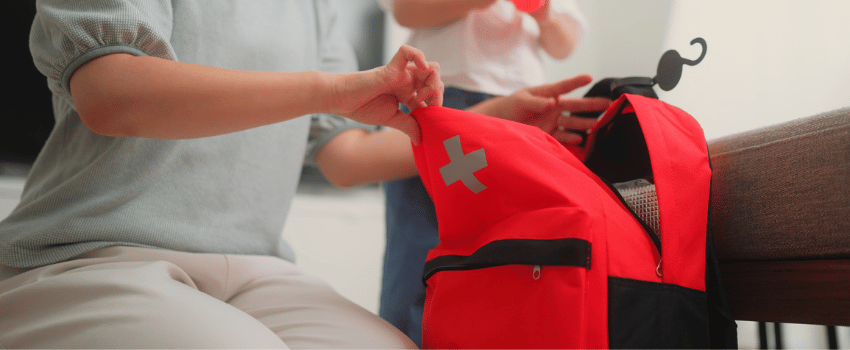
Nobody wants to think about worst-case scenarios, but when you live with an underlying condition like diabetes, it's an important part of being prepared. Preparation can be the difference between an emergency situation and a life-threatening event. While it’s just one more struggle of living with diabetes, there are ways to be prepared. One way to do this is to create a diabetes emergency kit with everything you need to effectively manage diabetes and treat any instances of high or low blood sugar. Here, we've created a detailed outline of what to include in your kit.
What is a Diabetes Emergency Kit Used For?
When you live with diabetes, having all of the essential medications and products necessary to address your medical needs in the event of an emergency is essential. Although prepping for a natural disaster or power outage can seem far-fetched, lockdowns during COVID and blackouts during harsh winter months have demonstrated that they're not only possible but actively happen. In general, being prepared for emergencies can make a huge difference, especially if you have a chronic condition like diabetes.
Sometimes, people with diabetes may also find themself in a medical emergency. Having the supplies necessary to address blood sugar fluctuations can make treatment more accessible. Whether you're living with type 1 diabetes, type 2 diabetes, or any other form of diabetes, it's important to make sure that you and your loved ones understand the signs and symptoms of any potential complications that require immediate attention. Some of these include:
- Diabetic Ketoacidosis (DKA)
- Severe Hypoglycemia (Insulin Shock)
- Hyperglycemic Hyperosmolar Syndrome (HHS)
Children living with diabetes should also have everything they need to address changing blood sugar levels while they're under the supervision of teachers, coaches, or any friends and family members. A small care kit can be put together for their management on the go.
How to Build a Diabetes Emergency Kit
Organization and foresight are key when building your diabetes emergency kit. This kit is your lifeline during unexpected events, so ensure you have all the tools you need to manage your condition effectively. However, time is an important factor to consider when building a kit. The length of time you plan for may require separate items. To further help you with this process, here are a few tips for building a diabetes emergency kit.
Choose a Sturdy Waterproof Bag or Container
The first step is selecting a durable bag or container to store emergency supplies. Opt for something waterproof and easy to carry, like a small backpack or plastic storage case with a secure seal. This ensures your supplies stay dry and organized, even in harsh conditions like heavy rain or flooding. Consider labeling the bag with your name and contact information for quick identification in case you get separated from it.
Pack Enough Diabetes Supplies
Next, stock your kit with at least a week’s worth of essential diabetes supplies. These might include:
- Insulin — Bring extra vials or pens with needles or syringes. Remember that insulin needs to be kept cool within your kit (more on this below).
- Glucose Monitoring Devices — Include a blood glucose meter, test strips, lancets, and a continuous glucose monitor (CGM) if you use one.
- Insulin Pumps — If you use an insulin pump, place an extra or replacement in your emergency kit (if possible). An old out-of-warranty model or box of Omnipods is a good option for backups. Also, include any insulin pump supplies and instructions if necessary.
- Batteries or Chargers — Keep extra batteries or a portable charger for your glucose monitor and other devices.
- Fast-Acting Carbohydrates — Pack items like glucose tablets, juice boxes, or candy to manage low blood sugar.
- Bottled Water — Staying hydrated is vital, especially during emergency situations.
- Non-Perishable Food — In case of long-standing emergencies, having a food supply can help you keep your blood sugar levels stable.
- Glucagon — Glucagon is a life-saving medication that helps quickly raise blood sugar levels in emergencies with hypoglycemia.
- Ketone Testing Supplies — If you’re at risk for diabetic ketoacidosis (DKA), include urine ketone test strips.
- Alcohol Swabs and Adhesives — For cleaning and securing medical devices.
- Medications — Bring all necessary oral medications for diabetes and other underlying conditions.
- First Aid Essentials — Add items like adhesive bandages, antibiotic ointment, and hand sanitizer for general emergencies.
- Flashlights or Candles — Lights can make administering medications easier in case of a power outage.
When putting all of these things into your kit, make sure that you label everything that can go bad with an expiration date. This can help you ensure that everything is safe and ready to use when you need it.
You may also want to include an explanation of your current diabetes management regimen in case emergency responders need to administer care. This may include your blood sugar target, basal rates, insulin sensitivity, correction factors for your insulin pump, and more. Additionally, it is recommended that you make a copy of all your prescriptions, all medical providers, your contact information, and an emergency contact and store them inside.
Be Mindful of Temperatures
Since certain diabetes medications can be affected by temperatures, it's important to choose a good location to keep your kit. Ideally, try to choose somewhere with a stable room temperature. According to the FDA, the ideal temperature for insulin is between 36°F and 46°F. It can also be left unrefrigerated at a temperature between 59°F and 86°F for up to 28 days and continue to work. The kit should not be in low temperatures that could freeze insulin, as this can damage its effectiveness. Any insulin that has been frozen should not be used, even after it has thawed. You should also avoid storing your emergency medical kit in direct sunlight or anywhere prone to water damage.
Best Practices for Emergency Preparedness
You should take a few other precautions to help ensure that you're all prepared for any emergency situations. Once you've put together your kit, consider the following tips so you're ready no matter what.
Create an Emergency Plan
Creating an emergency plan can help ensure that you and your family respond quickly to whatever is happening. Your plan should include evacuation routes, nearby shelters, and a checklist of essential items to bring if you must leave your home. For those with diabetes, this might mean extra time to grab your kit and refrigerate temperature-sensitive medications. Additionally, outline special instructions for caregivers or family members on assisting you with your diabetes management in an emergency. Make sure to review and practice this plan regularly with those in your household so everyone knows their role and feels prepared to act quickly.
You should also know how to find your local emergency preparedness resources, as this can help you understand where to report to for insulin or other diabetes needs in an emergency. Secondary locations are typically set up to ensure that traffic is minimalized near hospitals, health department buildings, and pharmacies, especially since they can be targets for looting.
Wear a Medical ID
Wearing a medical ID is a simple yet effective way to ensure you receive proper care in emergencies when you may be unable to communicate your needs. This can be a bracelet, necklace, or even a digital card on your smartphone that clearly states your diabetes type, any allergies, and emergency contact information. Medical IDs are especially critical in situations where first responders or healthcare providers need immediate information to make life-saving decisions. Investing in a comfortable, durable medical ID that you can wear daily is essential to staying prepared.
Update Your Emergency Contacts
Keeping an up-to-date list of emergency contacts is another critical step in emergency preparedness. Your list should include your primary care physician, endocrinologist, pharmacy, and close family or friends familiar with your medical needs. Store these contacts in multiple places—your phone, a written list in your emergency kit, and even a secure cloud-based location for easy access. Make sure the contacts you choose know their role in an emergency, whether providing support, delivering supplies, or coordinating with medical professionals on your behalf.
Teach Loved Ones How to Use Glucagon
In emergencies involving severe hypoglycemia, quick action is critical—and having someone nearby who knows how to use glucagon can save your life. Glucagon is a medication that raises blood sugar levels quickly, but it’s often administered by a loved one or caregiver when you’re unable to treat yourself. Teaching those around you how to use glucagon correctly ensures they feel confident and prepared to help in an emergency. You may also want to provide written instructions within your kit, just in case.
Keep Your Emergency Supply Kit Up-to-Date
Even the most well-stocked diabetes kits require regular maintenance to remain effective. Every three to six months, review the contents of your kit to ensure nothing has expired or been depleted. Check medications, glucose test strips, glucagon, and snacks for expiration dates and replace them as needed. Additionally, inspect the condition of any tools or devices, such as glucose monitors, to confirm they’re still functional. By keeping your kit current, you’ll avoid unnecessary stress or complications when you need it most.
Consider Multiple Kits
Emergencies don’t always happen at home, so having multiple kits can be a lifesaver. Create smaller, portable versions of your main kit to store in your car, at work, or in your child’s school bag. These kits should include the basics: fast-acting glucose, a spare glucose meter, test strips, and a written emergency plan or instructions.
For additional diabetes support and management, Byram Healthcare has a range of continuous blood glucose monitors. We also have a range of diabetes support and educational materials available to help you access everything you need for comprehensive care.




